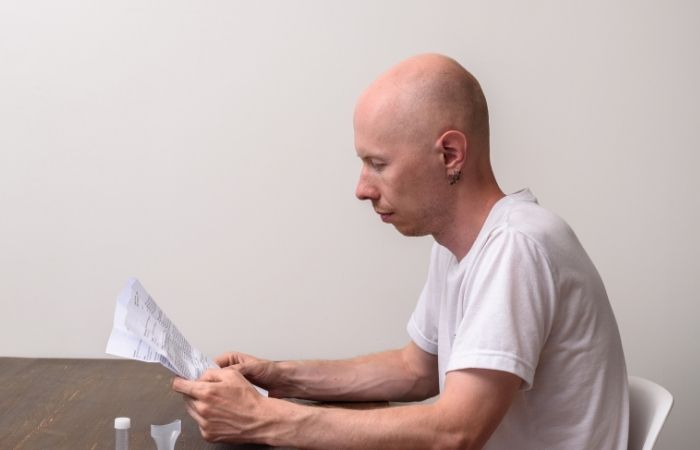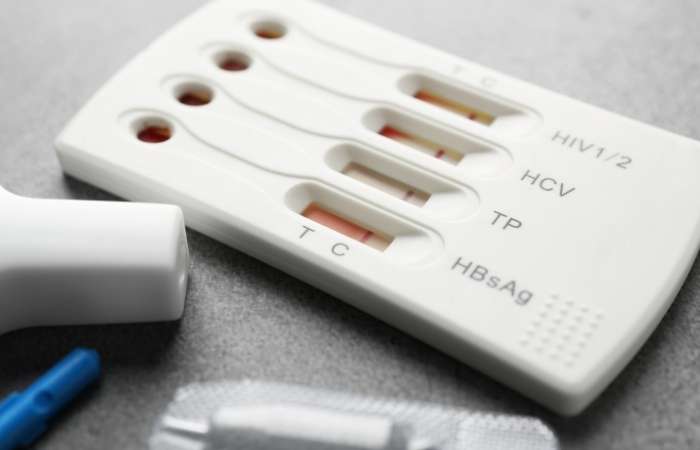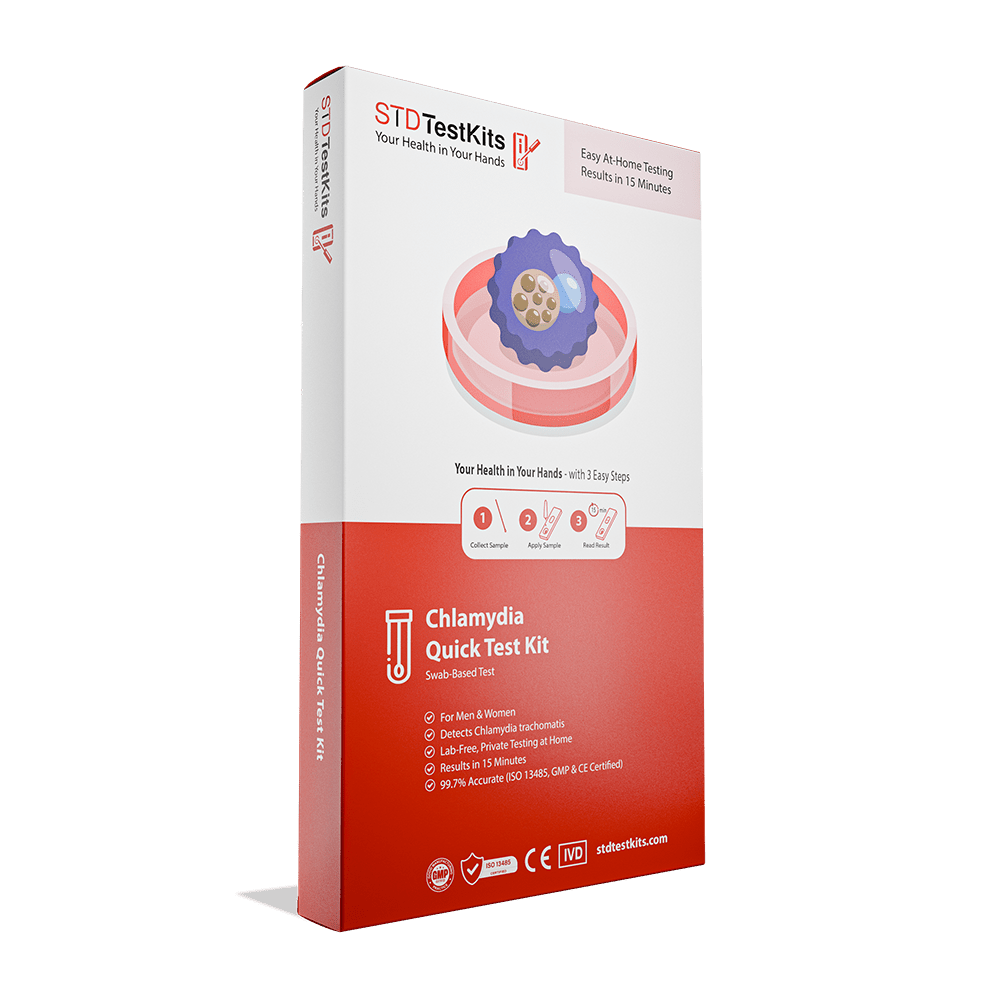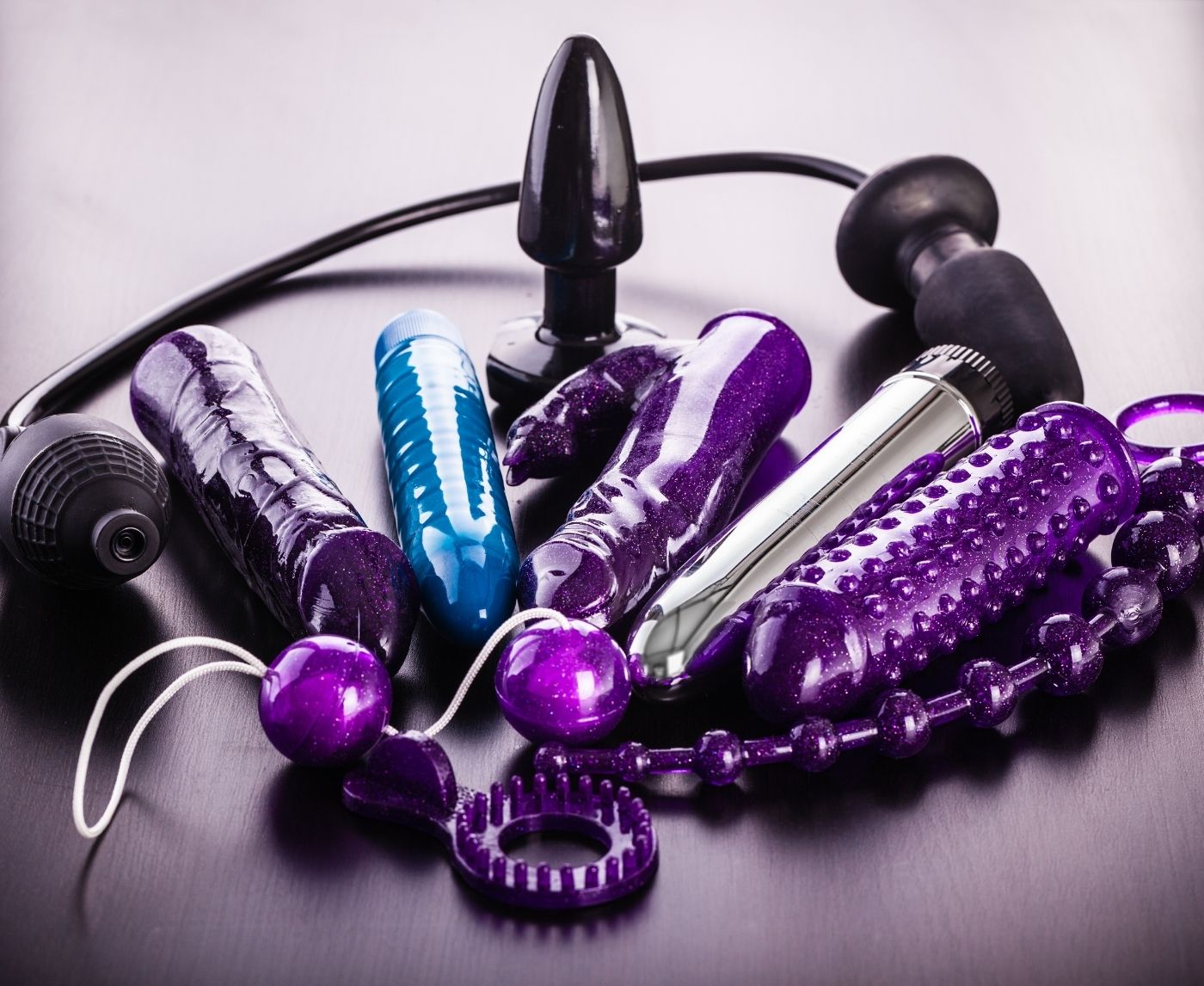Can You Get an STD from Oral or Toys? These Kits Can Tell You
Quick Answer: Use your chlamydia rapid test exactly as instructed, collect your urine or swab sample, wait the designated time, and read your results within the window. A faint line can still mean a positive. If you’re unsure or tested too early, retest in 7 to 14 days.
What Comes in the Box, and What It All Means
Most at-home chlamydia rapid tests come in discreet packaging with a few key components inside. If it’s your first time opening one, it might feel intimidating, don’t worry. Each piece has a specific role, and the instructions will tell you exactly how to use them.
Figure 1: Standard kit components found in most at-home chlamydia rapid tests. Always follow your specific kit’s instructions for best results.
Different kits may use slightly different mechanisms (some require urine; others a vaginal or penile swab). If your kit includes a swab, do not touch the tip or allow it to touch any surface. If it’s urine-based, use your first-morning urine for best concentration.
Before You Start: The Most Skipped Step (And Why It Matters)
It's normal to rush into testing. You want answers right away because you're nervous. But taking 30 seconds to get ready can make the difference between a result you can trust and one you can't.
Tip: Turn off distractions. Don’t scroll or cook dinner during the 15-minute wait. Being distracted increases the odds of reading the test at the wrong time, which can skew results.
Step-by-Step: Using a Chlamydia Rapid Test Correctly
The details are a little different for each brand, but the basic process is usually the same. This is a general guide that applies to most FDA-approved home kits:
- Step 1: Get your sample. If you're using urine, try to get the first stream of the day. If you're using a swab, gently put it into the vaginal canal or just inside the urethra if you're a man. Don't touch the tip again after you've collected it.
- Step 2: Add buffer solution to the mix. Put the swab or urine in the test tube or container, and then add the buffer drops as directed. If the instructions say to, swirl or shake gently to mix the sample well.
- Step 3: Put it on the test cassette. Put the sample mixture into the test well of the cassette with a dropper or the funnel that comes with it. Don't fill it too much.
- Step 4: Set the timer. Wait the exact number of minutes that are written down in the instructions for your kit. Most of the time, this takes between 10 and 20 minutes. Don't read the test before or after the time period given.
- Step 5: Look at the result. Look for lines next to "C" (Control) and "T" (Test). The "C" line should always be there. If it isn't, your test is not valid and you need to do it again.

People are also reading: Chlamydia from Fingering, Toys, or Oral? It’s Possible.
What That Line Actually Means: Interpreting Your Chlamydia Test Result
You're staring at the test strip. There’s definitely a line next to the "C", but is that a second line next to the "T"? Is it faint? Is it real? You’re not imagining things, this is one of the most anxiety-inducing moments in home testing, especially with chlamydia rapid tests. So let’s decode exactly what those lines mean.
Here’s how to interpret your result:
Figure 3: How to interpret control (C) and test (T) lines on a chlamydia rapid test cassette. A faint “T” line is still a line, and still a possible positive.
Important: A faint line next to the "T" is still valid. It means chlamydia antigens were detected, just at a lower level. You should treat this as a positive result unless told otherwise by a clinician. If you’re unsure, retest using a new kit or confirm via lab test.
Top 5 Mistakes That Can Skew or Invalidate Your Result
Even though at-home rapid tests are designed to be user-friendly, they’re still medical devices, and that means there’s room for human error. These are the most common mistakes that lead to false negatives, invalid tests, or panic-inducing misreads.
Testing too early
The most frequent issue. If you test within a few days of exposure, the antigen levels may be too low to detect, even if you’re infected. Wait at least 7 to 14 days after potential exposure unless you're symptomatic. Earlier tests should always be followed by a second test after the window period.
Contamination from handling the swab tip
The swabs themselves are highly sensitive. Brushing the delicate edge with skin, fingers, or any surface can transfer bacteria or change chemical makeup, especially if it's a vaginal swab that you have on hand.
Reading the result too early or too late
Reading for too long can have evaporation lines or ghosting that appear exactly like real lines; reading for too short a time can show a partial response. Always read within the time frame provided by your kit, which will typically be 10 to 20 minutes.
Overloading or underloading the test cassette
Too much sample fluid can flood the strip; too little might not trigger a chemical reaction. Use the provided dropper (or measurement guide) exactly as shown in the instructions.
Misunderstanding faint lines or discoloration
A smudge or shadow is not the same as a faint line. Faint lines have color, even if pale. If you're unsure, photograph your test at the exact read time and compare to a trusted image guide, or retest in 7–10 days.
Do You Need a Confirmatory Test?
Rapid tests give quick answers, but they aren’t the final word in every situation. Most clinicians recommend confirmatory testing for any positive result, especially when symptoms are absent. Even with negatives, a confirmatory lab test may be smart if you:
- Had exposure within the last 7 days
- Are experiencing symptoms like burning, discharge, or pelvic painHad a faint or questionable result
- Have a known exposure from a partner who tested positive
You can confirm your result with a lab-based nucleic acid amplification test (NAAT), often available through mail-in kits or at clinics. These tests have high sensitivity and specificity and are the gold standard for chlamydia diagnosis according to the CDC.
Bottom line: A rapid test is a first step, not a final answer. If you feel off or have any doubt, confirm. It’s not overkill, it’s smart sexual health hygiene.
Retesting After a Negative or Positive: What You Should Know
Whether your result was negative, faint positive, or invalid, retesting plays a critical role. Chlamydia can fly under the radar in early days, or come back even after treatment.
After a Negative
If you tested within 7 days of exposure, retest in 7 to 10 days. Antigen levels may not have peaked yet. If your partner tested positive, you should test again, even if you’re symptom-free.
After a Positive
Follow up with a healthcare provider and take prescribed antibiotics. You should not retest until at least three weeks after treatment ends. Testing too soon may detect residual antigens, giving a false positive.
Use this rule of thumb: If symptoms continue after treatment, or you’ve had new partners since testing, retest at 30 to 90 days.
Retesting isn’t obsessive, it’s responsible. It protects your health, your partners, and your peace of mind.

People are also reading: Can You Still Have Sex If You Have Chlamydia?
After the Test: Privacy, Disposal, and What to Keep
Once your test is read and documented, the answer remains: what next? No matter if your test came out invalid, positive, or negative, there are a few easy but significant procedures after the test, at least if discretion matters for you.
Disposal
Used test kits can be thrown in regular household trash, but wrap components in tissue or a sealed bag to prevent leakage or unwanted discovery. If gloves or swabs were used, treat them as biohazard-light, double bagging is safest if you're in shared housing.
Privacy Tip
Don’t leave packaging lying around. Most kits are shipped in discreet boxes, but the internal contents (like branded instruction sheets or barcodes) can give away what the test was for. Tear or shred papers before discarding if needed.
Save This
Some kits include a test ID or batch code that can help customer support troubleshoot if something went wrong. You don’t need to keep the test strip, but snapping a photo of your result and noting the time can be useful, especially if you plan to retest or speak to a clinician. Your sexual health is your business. At-home testing lets you keep it that way, but it still pays to plan your cleanup and follow-through with care.
Troubleshooting: What If Something Goes Wrong?
Sometimes, things don’t go according to plan. Maybe the liquid leaked, the line never showed, or your test looks nothing like the example photo. That doesn’t mean you’ve failed, just that you need to troubleshoot. Here’s how to make sense of common problems and what to do next.
Figure 4. Common rapid test issues and how to respond. When in doubt, don’t assume, retest or confirm.
FAQs
1. Can I truly do an at-home test for chlamydia?
Yes, as long as you read the instructions just right and test at the proper time. These kits do work and they have the same technology as clinic-based rapid test kits. Keep in mind, though: it's all about timing. Test too early after exposure, even the last test will miss an infection. That's not test failure, that's biology at work.
2. What if I touched the swab by accident?
It happens. If you touched the soft tip, dropped it on the sink, or weren’t sure if it grazed your underwear, play it safe. Swabs are designed to be ultra-sensitive, and contamination can throw off the chemistry. It’s not about judgment, it’s about accuracy. Use a new kit and try again, clean start.
3. Does a faint line mean I have chlamydia?
Yep. If you see a faint line next to the “T,” even if it’s barely there, that’s a potential positive. Think of it like a pregnancy test, light or dark, a line is a line. Don’t panic. Many people test positive and treat it quickly. But do take it seriously and confirm with a lab test or doctor if you can.
4. I didn't see any lines, did I do it the incorrect way?
If there's no control line ("C"), it didn't take the test. Either the fluid went beyond the strip or it's an out-of-date kit. Don't worry, it's not you; it's just something that sometimes occurs. Just grab another kit, repeat the instructions, and this time do it with a timer in a quiet spot so that you can truly pay attention.
5. How soon after sex can I test?
The sweet spot for chlamydia is 7 to 14 days post-exposure. Earlier than that, and the test might not detect the infection yet. So if you had unprotected sex last night and you're testing today? You’re ahead of the game, but you’ll need to retest later for real accuracy.
6. Is it safe to test while on my period?
If it’s a urine-based test, go for it, your period won’t affect the result. If it’s a vaginal swab, though, it’s best to wait until bleeding stops. Blood can interfere with the chemistry and give you a dodgy read. Wait a few days, then test confidently.
7. Why do I feel fine but still got a positive?
Because chlamydia is a sneaky little bastard. Most people have zero symptoms. That’s why regular testing matters, even if you feel great. You’re not weird. You’re just one of millions who caught it early. That’s a win.
8. What if I’m already on antibiotics?
Timing matters. If you’ve just started antibiotics (like doxycycline or azithromycin), they might lower the bacterial load enough to give you a false negative. Best move? Wait until after treatment to retest. Or confirm with a lab that can factor in medication timing.
9. Can I reuse the kit if I messed up?
Nope, these kits are single-use. Think of them like a match. Once you strike it, you can’t relight it. Toss the old one and use a fresh kit. Your peace of mind is worth $40 more than a questionable test read.
10. Should I retest after treatment?
Yes, around 3 weeks after finishing your meds. That gives your body time to clear dead bacteria and ensures the infection’s really gone. And if you’ve had sex since then? Test again at 6 weeks. Chlamydia’s a ghost sometimes, best to double check and move on with confidence.
You Deserve Clarity, Not Confusion
It can be scary to read a chlamydia rapid test, especially when the stakes are high and the lines are hard to see. But you don't have to go through it by yourself. You can go ahead with confidence, not panic, if you really understand how these tests work and what the results mean.
Do not hesitate to know your status, first time testing or follow up after treatment. This is an act of love for yourself and for anyone that is close to you.
Don't wait and ponder. Order a discreet chlamydia test kit online today and receive the answers you so rightfully deserve, on your terms and in your space, without having to wait.
How We Sourced This Article: We combined current guidance from leading medical organizations with peer-reviewed research and lived-experience reporting to make this guide practical, compassionate, and accurate. In total, around fifteen references informed the writing; below, we’ve highlighted six of the most relevant and reader-friendly sources.
Sources
1. CDC – STI Treatment Guidelines, 2021
2. Mayo Clinic – Chlamydia: Diagnosis & Treatment
3. Chlamydia Test Kit Instructions | TestHIVStatus
4. iCARE Chlamydia Field Use Rapid Test Kit Instructions | Jal Medical
5. What to Know About At-Home STD Tests | WebMD
6. Testing for STIs at Home — Reliability & Instructions | ASHA Sexual Health
About the Author
Dr. F. David, MD is a board-certified infectious disease specialist focused on STI prevention, diagnosis, and treatment. He blends clinical precision with a no-nonsense, sex-positive approach and is committed to expanding access for readers in both urban and off-grid settings.
Reviewed by: Dr. L. Nguyen, MPH | Last medically reviewed: September 2025
This article is for informational purposes and does not replace medical advice.






